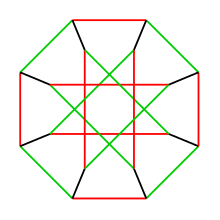Pauli group
From Wikipedia, the free encyclopedia

In physics and mathematics, the Pauli group  on 1 qubit is the 16-element matrix group consisting of the 2 × 2 identity matrix
on 1 qubit is the 16-element matrix group consisting of the 2 × 2 identity matrix  and all of the Pauli matrices
and all of the Pauli matrices
 ,
,
together with the products of these matrices with the factors  and
and  :
:
 .
.
The Pauli group is generated by the Pauli matrices, and like them it is named after Wolfgang Pauli.
The Pauli group on n qubits,  , is the group generated by the operators described above applied to each of
, is the group generated by the operators described above applied to each of  qubits in the tensor product Hilbert space
qubits in the tensor product Hilbert space  .
.
References
- Nielsen, Michael A; Chuang, Isaac L (2000). Quantum Computation and Quantum Information. Cambridge; New York: Cambridge University Press. ISBN 978-0-521-63235-5. OCLC 43641333.
This article is issued from Wikipedia. The text is available under the Creative Commons Attribution/Share Alike; additional terms may apply for the media files.